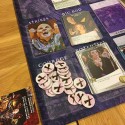‘Legendary: Buffy the Vampire Slayer’ Board Game Review

Although I can’t for the life of me think why it’s happening now (it is twenty years since the original series, so maybe that’s why) Buffy The Vampire Slayer has just been converted into the latest Legendary deck-building game. For those who are unfamiliar with them, the Legendary series is a collection of complete, out-of-the-box card games for one to five players that recreate pitched battles between famous (aka legendary) forces in popular universes from comics, film and television. Other universes to receive this treatment so far are Marvel, Aliens and Predator, for example, so you can probably imagine the kind of rivalry that you’ll see.
Legendary Buffy focuses exclusively on the 1997 TV series starring Sarah Michelle Geller et-al, and among the 501 cards (500 in later print runs thanks to a bonus “Dingoes Ate My Baby” card) you’ll find a set of fourteen cards for each of the heroes you might care to remember. You’ll also find five “Big Bad” enemies and a deck of tactics for each, a Scheme deck, a load of villain and henchman cards that pad out a Villain Deck, then several decks of more generic cards such as Bystanders, Wounds, Scheme Twists and more.
You won’t use each of these decks in every game however, and perhaps the most powerful thing about Legendary Buffy is the fact that it is capable of offering very nearly limitless combinations of Heroes, Big Bad’s, Villains, Henchmen, Schemes and so on. The most satisfaction to be had with it, certainly in my mind, is experimenting with the different mixtures to create powerful combos and challenging adversaries, whilst operating within the thematic boundaries of the series.
But what do you actually do in Legendary Buffy? What’s the game like to play? Well, despite the fact that the glossy and well produced manual swings wildly between being as clear as day one minute and incredibly confusing the next, Legendary Buffy is actually an incredibly simple game to play. Most of the effort is spent in setting up (and packing away) which is an area that is explained extremely well. Once the (large and very attractive) play mat is laid on the table, you will need to spend time setting up the various decks that inhabit its logical recreation of Sunnydale, but with that done, you’ll be ready to jump straight in.
Choosing which Big Bad to fight is fun, as is selecting the dark Scheme they wish to realise. You’ll then select decks of villains based on a combination of the Big Bad’s “Always Leads” rule and your own preference, as well as one or more decks of the weaker henchmen cards depending on how many players there are. You’ll then choose five (or more) hero decks to play with and place them into a specific pile. There are several more decks to place, but where most are concerned there is no decision to make – you either place the whole deck (Wounds or Potential Slayers for example) on a labeled space, or follow the Scheme or Big Bad instructions for Scheme Twist cards, for example. Usually, the only complexity involves shuffling cards from different decks into the Villain Deck.
Each player is then dealt twelve cards split between eight Watcher and four Initiative Solder cards, which then form the starting decks and are placed face down. Players then draw six cards each and the first player draws a card from the villain deck, placing it face up on the adjacent track. Some villains have Ambush actions that take effect right away, whilst others have different rules such as those that happen when you fight them, or under other circumstances.
As an example, some of these Villains increase the Light/Dark track towards darkness, which is a measure of the current threat level in Sunnydale. Conversely, some heroes and other effects move this tracker towards the Light, whilst others (on either Villains or Heroes) only take effect at a certain Light or Dark level. This is easy to keep track of thanks to a dedicated on board indicator and a specific token. Every time a Villain enters Sunnydale, all other adjacent Villains move one space closer to escape, meaning that players must defeat them within a set number of turns or face a (sadly fairly minor) consequence. It’s important to know that Villains only move along one space, which means you can buy an extra turn by defeating any Villain on board so that the next Villain moves into the empty space, which stops the sequence of movement.
Bearing in mind that drawing the Villain card is still the first part of a player turn and I’ve made it sound very complicated, in practice it’s over in a few seconds usually. Next up, the player plays cards from their hand (any amount and in any order) by placing them on the table. At the beginning of the game, Initiative Soldiers simply offer one attack point each, whilst Watchers provide recruit points. If you play three Initiative Solders, for example, you’ll have three attack points and will be able to Fight and defeat a Villain with the same or less, resolving any Fight action on the Villain card at the same time.
Recruiting is more interesting, at least early on. At all times during play you’ll have five hero cards in The Library spaces and if you can meet the stated cost, you can recruit any of them. If there are no decent (or affordable) options, then you can recruit a generic Potential Slayer card, which is a cost effective but unexciting way to increase your recruitment potential for later turns. Once you’ve attacked and recruited all you can or want to, all cards (including those you didn’t use) are discarded into a face up pile, at which point you draw six more. If your face down deck runs out at any point, you reshuffle your discard pile and draw from the top (face down.) As you recruit more cards, your deck expands and the key to success in Legendary Buffy is to create a powerful and synergistic deck that delivers your killer cards and combos as often as possible.
This process goes on for as long as it takes to either defeat the Big Bad (by beating them in a Fight four times) or for them to achieve the Evil Wins condition(s) on the Scheme card. Generally speaking, Villains take the upper hand early due to the relative weakness of each player deck, but the tide changes after a number of rounds of play. There are numerous ways to affect the difficulty by shuffling in certain card combinations or additional decks, so there is a lot of potential for fine tuning if you find your first few games too easy (as I did.)
Overall, the quality of everything in Legendary Buffy is high, but I would say there are a few missteps here and there. As I’ve mentioned, the manual is hit and miss, but the card stock and content is generally very good, with great paper quality and a decent and varied selection of images. Several decks of cards include a lot of repetition, but as any deck builder knows, knowing what each does and your chance of drawing it is the key to consistency and performance with any card game like this. I guess I would have liked to see more images used on generic decks (like Wounds, for example) but by keeping things consistent, the game is easier to play quickly as there are more visual cues.
There are some ambiguous rules and some card text that is open to interpretation, but the really key omission from the manual is a clear key for what each symbol on the cards means. Instead of a handy summary or inclusion in a paragraph, these items are only explained in a tiny picture explaining each card face. The play mat is really, really nice and does a good job of representing Sunnydale’s key locations, as well as the flow of gameplay. I was a little disappointed to see that the card dividers were not labeled, which seems a bit cheap because it basically forces players to write on them in pen, but I suppose you could always print your own instead (and indeed players on boardgamegeek have already done so.)
The game itself is actually a lot of fun and it is one of the few games that I can remember which is interesting as both a solo or multiplayer proposition. It works in a very similar way however you play, with multiplayer taking the guise of a competitive-cooperative game in which players work together to beat the Big Bad whilst also competing for victory points earned by defeating Villains and Big Bad Tactics whilst still drawing from the same Hero Deck. Arguably, playing with more players can be harder due to greater competition for the best cards (and even with more Hero sets, there are still only five library spaces to draw from) but at all player counts, the base game is a little easy. Thankfully, the manual does advise on ways to make it more challenging, right up to virtually impossible.
In terms of recommendation, I’m going to score Legendary Buffy from the perspective of a “moderately interested” fan of the series and also as someone who really loves the series, because I think it is an important distinction. The theme here is very strong, as is the fan service, and this feels like a Buffy The Vampire Slayer related product through and through. For anyone else, Legendary Buffy is still a very solid game and I really do like how adaptable it is in supporting replayability and variable player count. It’s also just a lot of fun. Because Legendary games are so strong on theme, you might consider one of the IP’s I mentioned earlier a better fit for you, so if that’s the case you should go with your preference.
Based on overall decent quality, fun, simplicity, replayability and thematic robustness, I rate Legendary Buffy:
3.5/5 for most people, or 4.5/5 if you are a big fan of the series.
_____
You can buy Legendary: Buffy The Vampire Slayer online at 365Games.co.uk, or at your local games store. Don’t know where yours is? Try this handy games store locator.


























































